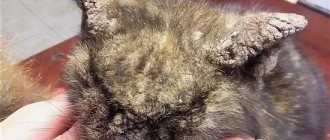July 17, 2020
Pyometra - purulent inflammation of the uterus - is one of the most common diseases of the reproductive system of cats, and also one of the most dangerous.
This disease is caused by a bacterial infection and occurs in acute or chronic form with the accumulation of purulent exudate in the uterine lumen and can have a variety of clinical manifestations.
With the progression of symptoms and the absence of timely treatment, pyometra leads to peritonitis, which occurs due to rupture of the uterine wall under the influence of a large amount of accumulated purulent exudate.
Who can get pyometra?
Cats are less likely to develop pyometra than dogs. This may be due to less progesterone being released. Unfortunately, due to the lower prevalence of the disease in cats, fewer factors are known to contribute to or prevent the development of pyometra in cats.
However, it is known that older animals are most susceptible to the disease; the risk of the disease increases significantly after 7 years, the average age of onset of pyometra is 5.6 years. Despite this, pyometra can also occur in very young animals - even a ten-month-old cat can get sick.
Only castration can completely prevent the development of purulent inflammation of the uterus. A cat’s history of childbirth, according to research, also does not in any way protect it from the disease.
It is also reliably known that previous hormonal therapy associated with the intake of progesterone contributes to the development of pyometra, therefore the use of drugs to suppress sexual estrus in animals is extremely undesirable.
Connection with hormones
The etiology of purulent inflammation of the uterus is associated with changes in the titer of sex hormones during the reproductive cycle. Pyometra is called a progesterone-dependent disease, it manifests itself in a phase of the cycle in which the concentration of progesterone is high and estradiol is low. This phase is diestrus - the end of estrus and the period immediately following it until the stage of ovarian rest.
Progesterone promotes the growth of the uterine glands, an increase in the amount of their secretion, the closure of the cervix, a decrease in the number and intensity of its contractions, which creates the ground for the subsequent proliferation of microflora and the development of the disease. Progesterone also mediates the pathological proliferation of endometrial glands and the formation of cysts, thus causing glandular cystic endometrial hyperplasia, a disease that often precedes and accompanies pyometra.
No less important is the second factor that causes purulent inflammation of the uterus - a bacterial infection. During estrus and shortly after its end, the internal environment of the cat's uterus is optimal for a possible pregnancy, but also for the growth of microorganisms due to the presence of a large amount of uterine gland secretion and suppression of the immune system. And when pathogenic or conditionally pathogenic microorganisms enter the uterus, inflammation begins.
Preventive actions
Prevention of pyometra in cats is as follows:
- carrying out sterilization before or after the first heat, if the animal does not participate in breeding;
- conducting a scheduled annual ultrasound examination of the animal’s reproductive system;
- monitoring the progress of labor, if it drags on too long, you should contact a veterinarian;
- Constantly monitoring the animal’s condition and if dangerous symptoms are detected or discharge appears, contact a veterinarian with the cat.
In addition, you should not give your pet contraceptives that eliminate estrus. Since if they are used frequently, the cat becomes susceptible not only to the development of pyometra, but also to cancer of the uterus or mammary glands.
Bacteria that causes pyometra
The most common bacteria that cause the development of pyometra are three genera:
- Escherichia (most often the bacterium Escherichia coli, also called “Escherichia coli”), is isolated from the affected uterus.
- Streptococcus (streptococci).
- Staphylococcus (staphylococcus).
Bacteria and their metabolic products, such as various toxic compounds, begin to circulate in the body, causing inflammation in various organs and systems, and can lead to fever, tachycardia, tachypnea (rapid breathing), shock and failure of internal organs.
Pyometra is characterized by an effect on the entire body of the animal; according to statistics, a septic process was detected in 86% of cats with pyometra.
Symptoms of pyometra in cats
Clinical symptoms of pyometra usually appear between 2 and 4 months after the end of estrus (but can appear at any other phase of the cycle) and can be varied.
Most often, mucous, purulent, and bloody discharge from the loop occurs, but they may not appear in closed type pyometra (in cats in 40% of cases). In this case, the cat will develop general symptoms indicating intoxication of the body and damage to various organs and systems.
The most classic symptoms are: exhaustion, depression, frequent urination, thirst, rapid heartbeat and rapid breathing, weak pulse, change in color of visible mucous membranes. Less common are fever, dehydration, abdominal tenderness, vomiting, diarrhea, and changes in the cat's gait.
What symptoms might there be?
Very often, clinical signs at the onset of the disease are not specific. But basically the clinical picture of symptoms can be manifested by the following signs:
- There is a decrease or complete absence of appetite in the cat;
- Polydipsia (the animal’s feeling of thirst increases, the amount of fluid consumed increases);
- Polyuria (increased diuresis, possible urination past the tray or in inappropriate places);
- Frequent licking of the genital area.
If the course is prolonged, vomiting may appear, the cat becomes more lethargic and tries to hide. Sometimes hyperthermia, diarrhea, and changes in the quality of the coat are observed. Body temperature most often increases at the beginning of the disease, and then decreases to normal (normal -37.5-39.5). In severe cases, a state of shock may develop.
Also often, owners notice a pronounced increase in abdominal volume and therefore may confuse pyometra with pregnancy (this applies to free-range cats).
With the open type, vaginal discharge is still observed. They are mucous with impurities of pus or blood clots. Thanks to this drainage of the mucopurulent contents of the uterus, the risk of overstretching the walls of the uterus and further perforation with accompanying purulent peritonitis is reduced. Animals with a closed form of pyometra suffer much more seriously and may die. Due to the closed cervix, there is no drainage of pus and it accumulates in the uterus. Gradually it increases in volume and intoxication develops, rotting products enter the blood. In the subsequent course, this can lead to uterine rupture and pus entering the abdominal cavity. As a result, purulent peritonitis develops, which worsens the prognosis.
Any of the above symptoms should alert the cat owner. If you notice at least one of them, a mandatory examination of the animal by a veterinarian is required.
How is the diagnosis made?
Making a diagnosis of “pyometra” is not difficult in classic cases based on history, examination, and physical examination, but there are also difficult cases with an atypical picture of the disease.
To make a diagnosis, the cat will need to be examined: blood tests, an ultrasound examination of the abdominal cavity, and an x-ray may be required.
A clinical blood test usually shows a high number of immune cells: leukocytes, monocytes, neutrophils and anemia; a biochemical blood test indicates kidney damage.
An X-ray examination can show the size of the cat's uterus, and an ultrasound can also help detect fluid in the organ cavity. If research data is available, the diagnosis will be final and reliable. Additional diagnostics are almost never required.
Diagnostics
If you notice symptoms of pyometra in your cat, you should immediately contact a specialist. Pyometra will never heal on its own; any delay can cost the life of your pet.
The easiest way to make a diagnosis in a veterinary clinic is an ultrasound of the uterus. True, in this case it is important to distinguish pyometra from hydrometra, mucometra (other diseases of the reproductive system). To do this, a smear is taken, a detailed blood test is performed, and the animal’s medical history is examined.
The infection, of course, can be detected by blood and urine tests, but in this case the exact location of the inflammation will not be determined. An X-ray can also help diagnose the disease: the photo will show a gap in the uterus.
Treatment of pyometra
There are two main treatment strategies for pyometra: surgical and conservative.
Surgical treatment is the most common and safest method: it is guaranteed to stop the development of the disease and remove the source of infection from the cat’s body.
The operation to remove the ovaries and uterus (ovariohysterectomy), which is performed for purulent inflammation of the uterus, begins after stabilizing the patient with the help of an intravenous infusion, carried out to relieve intoxication and restore fluid balance in the body.
During surgery, monitoring is aimed at maintaining normal blood circulation, gastrointestinal function, maintaining breathing and the required depth of anesthesia. The removal of the uterus is carried out very carefully to prevent its contents from entering the abdominal cavity. The bladder can be emptied if necessary by puncturing its wall (cystocentesis).
Danger and complications
The main danger of the disease is death from acute peritonitis. It occurs when the endometrium ruptures, causing the entire abdominal cavity to fill with pus.
Another possible complication is falling into a coma due to dehydration. In this case, the body is severely depleted, so the likelihood of recovery is minimal. Most often, the animal dies without regaining consciousness.
Postoperative period
After surgery, the cat should be monitored for 1-2 days in a hospital or at home. Treatment is prescribed in the form of antimicrobial and supportive therapy. As a rule, the recovery period lasts 2 weeks, after which the consequences of the disease and surgery disappear.
In the postoperative period, it is important to strictly follow all doctor’s instructions. Your cat may be prescribed a variety of medications, including injections (shots) and infusions (droppers). Owners will need to monitor the condition of the cat, inspect the seam, ensure that it remains dry and clean, and treat it if necessary. After surgery, it is important to prevent the animal from hypothermia, not to expose it to stress, and to feed it regularly.
The prognosis for surgery is quite favorable and depends on the age of the cat, the presence of concomitant pathologies and, first of all, the severity of the disease. Mortality during surgical treatment of pyometra ranges from 3 to 20%. A cat with uterine rupture and subsequent peritonitis has a 57% chance of dying during and after surgery, so it is so important to pay attention to the first signs of illness in the animal.
Caring for your cat after surgery
After surgery (removal of the uterus and ovaries), your pet needs appropriate care. When carrying out care you must:
- Put a post-operative blanket on the cat (sometimes this is done in a veterinary clinic) so that the cat does not chew or lick the post-operative stitches.
- Inspect the surgical suture daily. If redness or inflammation appears at the suture site, the cat must be taken to the veterinary clinic where the operation was performed.
- Despite the fact that the cat may lose its appetite after surgery, the cat should have free access to water.
- After surgery, the cat is prescribed a special veterinary diet (pates) or chicken broth with chopped meat. The cat must be fed soft and semi-liquid food.
- If there is any deterioration in the general health of the cat, it is necessary to show it to a veterinarian.
Drug treatment of pyometra
Abroad, drug treatment of pyometra is increasingly being used to replace ovariohysterectomy in the absence of pronounced symptoms of the disease and the need for emergency treatment. The drugs most often used for therapy are aglepristone, a progesterone antagonist that blocks progesterone receptors in the uterus, and cloprostenol, a luteolytic agent aimed at stopping the production of progesterone by the corpus luteum.
At the same time, antibiotic therapy is carried out to eliminate bacteria that create an inflammatory process in the uterus and urinary system. It should be noted that conservative treatment of pyometra is criticized by the veterinary community, primarily due to the high risk of relapses at the end of the course of treatment (from 10 to 30%), therefore the most reliable way to cure purulent inflammation of the uterus is still surgical. Moreover, it is the only possible one if the animal is in serious condition.
It is important to remember that drug treatment can only be chosen if the cat is young and does not have concomitant diseases and general symptoms of purulent inflammation of the uterus. The main advantage of such treatment is the preservation of the cat’s reproductive function, however, despite the normal course of pregnancy and childbirth, pyometra can return at any time. This treatment strategy is only advisable for animals of exceptional breeding value or if the cat cannot be subjected to surgery.
Prevention of pyometra
Pyometra is an extremely dangerous disease that can potentially lead to death if left untreated, so if an unneutered cat shows symptoms of the disease, you should contact your veterinarian immediately.
You also need to remember about the only way to prevent purulent inflammation of the uterus - castration. Timely castration of non-breeding animals can save the cat and its owners from many unpleasant experiences associated with the treatment of pyometra, and possibly even the death of the pet.
Back











